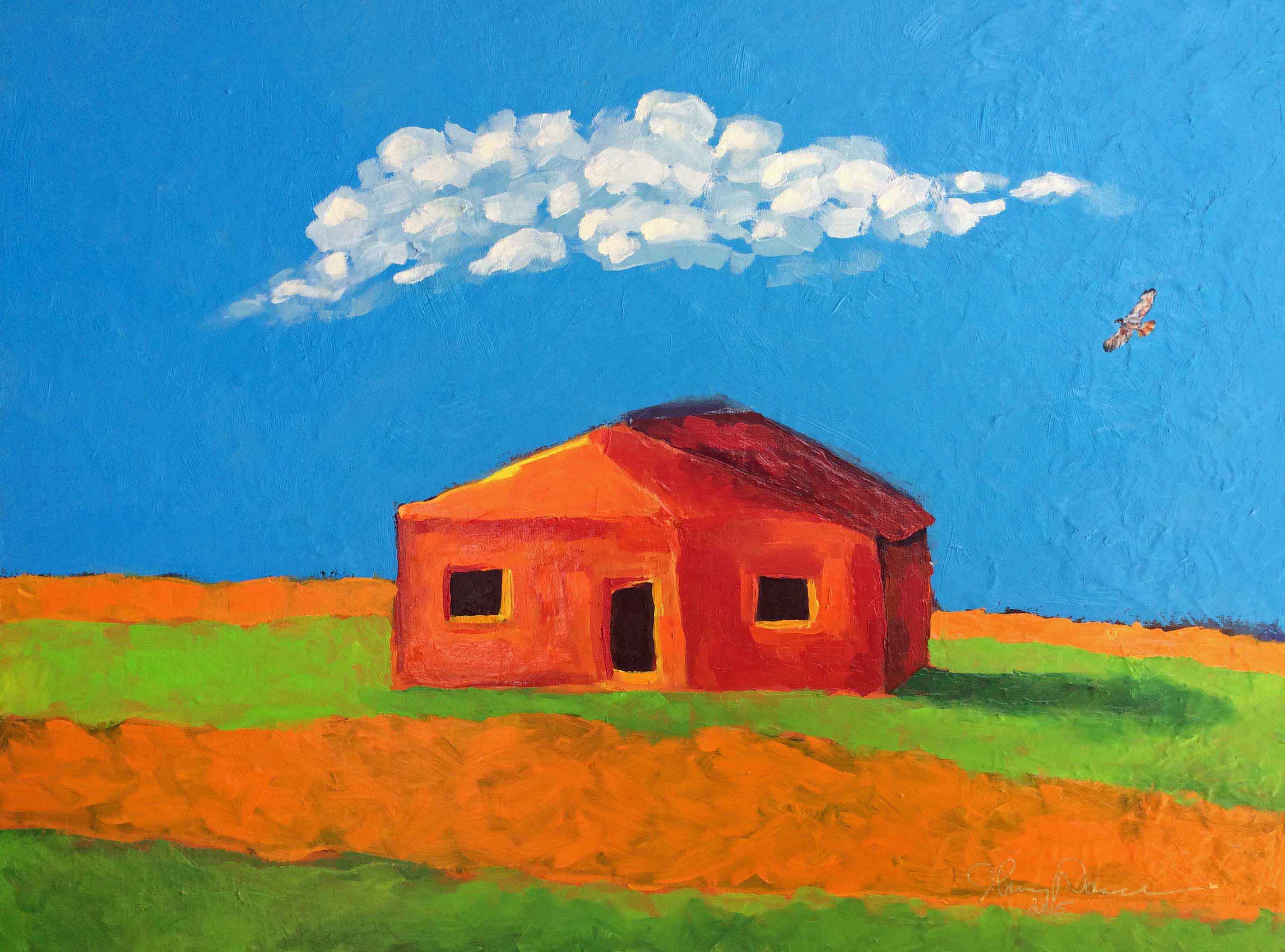
Journal Texican
Volume 1, Number 2
Mobeetie Had A Courthouse
Dr. June Welch and I came off the Caprock in 1968 finishing up a series of two to four day weekend trips that captured on film all 254 Texas County Courthouses which in turn coalesced into a book of the same name.
This particular trip into the northeastern quadrant of the Texas Panhandle took us through a trio of original Panhandle settlements: Clarendon established in 1878 by L.H. Carhart as a “sobriety settlement which local cowboys dubbed “Saints Roost;
Mobeetie (Cantonment Sweetwater-Mobeetie: Native American for Sweetwater) located on the North Fork of the Red River that was first a buffalo hunter’s camp called “Hidetown”, a destination for stagecoach freight and buffalo skinners, a place Charlie Goodnight remarked: "I think it was the hardest place I ever saw on the frontier except Cheyenne, Wyoming." Robert Clay Allison, known for hitting the bottle and general hard living, rode his horse through Mobeetie drunk a la Lady Godiva before marrying the obviously either adventurous, or desperate, America Medora “Dora” McCulloch on February 15th, 1881; and Old Tascosa in Oldham County, the former capital of ten Texas Panhandle counties, in the 1880’s rivaling Dodge City, Kansas in economics; built a stone court house in 1884 for $18,000; was frequented by Billy the Kid and Pat Garrett; immortalized with the March 21, 1886 “Tascosa Gunfight” that claimed four gunslingers; was home to Cal Farley’s Boys Ranch built in 1938; was the setting for the movie “Winchester 73” produced in 1950; and boasted a boot hill cemetery.
A frame building, a little off the highway, was photographed and remembered as the Clarendon Courthouse because the original Clarendon settlement was recalled to have been moved to be close to the tracks when the railroad was built. Mobeetie, memory held, lost its county seat designation also due to the coming of the railroad.
Back in Dallas, sometime in 1972, a pair of paintings, 30x40 and 12x16 inches, (the first an overpaint of an unfinished religious themed copy) were done, inspired by the old lost courthouse which, when the photograph was shot, was inhabited by the local Lions Club.
Both paintings were stored, along with a mixed media drawing, thinking that the 30x40 would be finished with some additional elements.
English writer William Hazlitt (10 April 1778 – 18 September 1830) in his essay “On the Pleasures of Painting” describes exactly who is the painter (the artist), what and why art (in this case painting) is of importance our life oeuvre which, if one has not read same, should as it helps put, in perspective, this modest note.
The 30x40 was re-discovered, the painting updated and finished; and upon clearing one’s head, discovered the illustrated courthouse did not belong to Clarendon, but rather Mobeetie, the town long gone, remembered graphically on that particular day of the ‘70’s in the northeast Texas Panhandle, small and alone in a vast Texican sky that spoke, and speaks still, volumes.
THE BURNING BUSH
Reprint from Amateur Astronomer by J. Larry Nance
Revelation
Pink, pale magenta morning light,gold-evening Lone Star light makes everything come into edge-sharp focus. In the Caymans the light is white, in New York: obscured, Mexico City andLos Angeles: bilious, Italy: yellow-gold, Carmel: fog filtered. On a Martian evening, the light is diffused from a small grapefruit yellow circle going down under strings of ice blue clouds.Through the windshield under the visor, running east late to work, Re-Harakhty is for me the moment symmetry was broken. Such light: a collective manifestation of quantum chromodynamics, the smallest of the small, and from here the beginning of the largest of the large, a blazing portal, a manifestation of blinding insight, a sign in the sky: the Fifth Dynasty god of light Re, a beckoning Mt. Sinai marvel. This Apollonian sphere creates and marks time. It makes life. It kills, all without intent and malice. For the most part, it is ignored, taken for granted.
It lives against a back drop of universal darkness, turned inside out as incredible balls of stars, sheets of stars, spheres of such beauty that they slide one into the “marvelous, unborn, illuminating Buddah mind” of BankeiZen as they glide into telescopic view. Watching these counterpoints is addictive, driving a visceral need to see more and more with no thought of eating, drinking and sleeping. This is voyeurism light years beyond Eyes Wide Shut.
drop of universal darkness, turned inside out as incredible balls of stars, sheets of stars, spheres of such beauty that they slide one into the “marvelous, unborn, illuminating Buddah mind” of BankeiZen as they glide into telescopic view. Watching these counterpoints is addictive, driving a visceral need to see more and more with no thought of eating, drinking and sleeping. This is voyeurism light years beyond Eyes Wide Shut.
The 60 days of my two logged year 2000 solar cycles are signified by July, August and September record-running Texican drought, with other western states ablaze, and normal, but symbolic, open water at the North Pole.
As the decade turned from the 1940’s to the 50’s, a Fort Worth retail family, the Leonard’s, refrigerated air-conditioned their wonderful sprawling store blocks from the Tarrant County gingerbread red/grey granite courthouse. It was a first. Going in was a marvel of cold. I roamed the store for hours and years later would buy a little ornamental Tasco refractor.
Coming out of that meat locker, the heat slammed you up side of the head taking your breath away. You would stagger for a moment, squinting, looking for shade, steam rising off the top of your head as you made your way to the bus stop. The ride home in a tin box with the windows down made you give thanks for the moving bus stirring a hellish breeze, all the while your system’s still trying to compensate from the artificial Texas norther.World-class sculptor and friend Gene Owens whose studio was south of Fort Worth outside of Cleburne, told me one August afternoon in the 70s, with the temperature 111 Fahrenheit and rising, casting wax melting in giant cauldrons ready for us to pour into snow-white molds, that “there is no hell, this is it.”In retrospect he was being pouty.
The Capture
I decided to observe and record the three-month cycles as a solar maximum participant. Before, the Sun was of little interest. It is there and it is summer hot. But in the bigger picture, the thing about which I have always been aware, and memory held, are vagaries of light.
And so the light, and the Astronomical League’s challenge, drew me to mount my maligned Celestron C-90 on an Orion equatorial, fit the end with a like brand glass solar filter, get a 5.5” x 8.5” Strathmore Sketch book with 100 pages, a Koh-I-Nor 0.5mm Rapidomatic mechanical pencil, a notebook, and copies of Zurich/McIntosh classifications and values after Malde copied off of the internet. I commence observing on the ninth of July, 2000.
The C-90 is fitted with an 1.25” adapter and 22mm TeleVue Nagler eyepiece providing a clear view of the entire disc. This particular C-90 was rejected as a sale and returned right before Christmas of ’99 as being “worthless.” The appellation was accompanied by diatribes and postings concerning the offering and my character on an Internet astronomy chat room where, unbeknownst to me, my honor was defended by friends and others. I sent the little scope directly to Celestron for cleaning and alignment, or whatever else they do for $125.00 plus postage, upon arrival from the truculent, failed, customer. I had regretted selling the C-90 anyway having planned to use it for solar observing, and as a finder scope for the 8 and 25 inchers. I was, with the exception of shelling out a C-note plus a quarter, relieved to get it back, dispersions not withstanding.
The C-90 is a beautiful little spotting scope, its only draw back being that focus is accomplished by turning a large ring on the body. But once in focus, it stays there. And, it is portable. Every afternoon after work I carry the assemblage easily into the back yard. I move from the back porch a little antique green, iron, garden chair, exactly the right height The Bride has told me repeatedly not to use, to the scope. I align by holding the current sketchbook page until the scope’s shadow is cast sharply, and then adjust in azimuth and declination until the shadow is as circular as possible on the sketchbook page. Most of the time the gold image is waiting dead center in the eyepiece. Other times, mysteriously, I have to adjust before commencing the run.
Gene, my previously mentioned Texas Wesleyan University art professor, taught me gesture and contour drawing. Contour drawing I employ to great effect in this solar application. I simply glance at my sketchbook, look into the eyepiece and checking the page, position the pencil loaded with HB lead at a beginning point matching a spot in the eyepiece. I then pretend I am touching the sun’s face in the eyepiece with the pencil. I move to the next object with my eye and at the same time move my pencil, eye and pencil in coordination. Everywhere I drag my view, my pencil draws. I never look at the page except when I move to a spot far away from the one on which I’m working, and to fine adjust the telescope as the Sun moves out of field. I then re-align my pencil to the page with my next spot in the eyepiece and commence again, pretending I am touching with the pencil with what I am seeing in the eyepiece.
Using this Zen-like technique gives me the ability to concentrate on the eyepiece, not the drawing. The drawing takes care of itself. If the object has a fine line, I use a light touch. If the object has a dark area, I use a firmer touch, filling in areas in concert with the light and darks I am gathering from the eyepiece. I use cross-hatching (x’s) for some shadowing, light, parallel strokes for other shadowing, particularly on the limb. I contour the temperature changes with lightly drawn ovals. All of this heady technique is lost, of course, on lightly spotted days.
I use one of The Bride’s lovely, heavy, crystal cocktail glasses to draw a sun circle template on the top half of the page. On the lower, I record the date, military time, telescope type and eyepiece, temperature, and sky condition (cloudy, partly cloudy, hazy, clear). Around the circumference I label each spot and spot collection with a letter that is then recorded in descending order on the bottom of the page. Next to each label letter is the spot count and its Zurich/McIntosh/Malde classification (of which there are 60).
The classification includes in part:
- Axx: Unipolar, no sunspot penumbra, single spot;
- Bxo: Bipolar, no sunspot penumbra open spot distribution;
- Hrx, Unipolar, rudimentary sunspot penumbra, single spot;
- Cro: Bipolar sunspot to one side, rudimentary penumbra, open spot distribution;
- Cri: Bipolar one side, rudimentary penumbra, intermediate distribution;
- Hax, Unipolar, asymmetric penumbra <2.5 degrees, open distribution;
and so on.
It’s more than the Astronomical Society and Texas Astronomical Society’s observation coordinator and former phantom Astronomical League proctor is asking, but I do it anyway having trouble following directions always. Later, the proctor notes approval.
For the complete sun spot classification list, as well as other interesting observational instruction information, log on to: http://www.cv-helios.net/
Also check out:
http://www.exploratorium.edu/sunspots/;
http://web.ngdc.noaa.gov/stp/SOLAR/SSN/ssn.html; and
http://web.ngdc.noaa.gov/stp/SOLAR/solar.html.
I also count the number of labels at the bottom of my list, multiply by 100 and add the total spots for the Wolf (R) number, (Johann Rudolph Wolf, 1816-1893). Wolf developed sunspot indexing R = k (10 g +s) where S = number of individual spots, g = number of sunspot groups, and k is the observatory factor. The then director of Zurich Observatory confirmed a non-symmetrical 11.1 year sun spot cycle averaging 4.8 years waxing and 6.2 more years to fall back to minimum. The largest annual mean number of 190.2 spots was recorded in 1957. Wolf also mapped the sun spot cycle to Earth’s magnetic field disturbances.
Poetry
Throughout my two-cycle discipline I record 37 days of outstanding sun spot activity, R’s ranging from a low of 81 up to 225. The first time out I record a Fac group of bipolar spots more than 15 degrees with asymmetric penumbrae less than 2.5 degrees. The compact group of strange looking fuzzy rimmed eyes is strung out in my inverting eyepiece at 6 o’clock, describing in clear foreshortening, the great Re.
On another day there are asymmetric penumbrae paramecium more than 2.5 degrees total length dead in the center, logged as 14 Fkc’s, with more than 15 degrees of bipolar spread.
On Day 11 there is clear limb darkening at the bottom of the inverted field, clearly defining dimension, tucking 9 Fac’s directly at the bottom.
Day 14 reveals photosphere mottling resembling clouds in a sea of white-yellow on white-yellow, Unipolar rudimentary single penumbra CV’s flanking the edge field at 1 and three o’clock. And, in a Dsi group, a light bridge connects a huge symmetrical penumbra’s smoky black eye with a tiny unipolar spot void of shadow.
Day after day I draw, and on one the ancient Horus falcon flies through the field, his wings the sky, breath the wind, left eye the moon, right the sun. His feathers gleaming sunrise and sunset. His breast speckles: clouds.
It is one thing to observe in a cloudless sky, quite another in a scudding one: thin versus smoke then solids drawing a quick, silent veil. You miss the blazing bush quickly, waiting futilely for Re-Harakhty to come back, but he’s gone, sinking from his celestial 12 domain day high-flying celestial sail, for that of a 12 domain Tuat underworld barcarole.
The Rose, who then was six, comes over with Horus’ speckles now blown away and I show her a particularly large spot, some 600 earth’s diameters.
She observes, then turns to me, the gold light bathing her face, holding both my hands tightly, and exclaims in a whisper:
“Papa, we’re just dolls!”

“…There is nothing like a blood-curdling hymn to make you feel quite at home….” Watchman
Ernest Hemingway despised professional critics, called them sharks, and wrote The Old Man and the Sea as example of same. Truman Capote called critics “typists”. In a pique of irritation over some now forgotten depredation, I depicted one in a gouache drawing as a race horse with two broken front legs.
Prior to the release of Harper Lee’s new “Watchman”, the sharks were out in force telling us what “to look for, what to expect.” I made it a point to ignore each and every one of them. Don’t tell me how to read!
I fell in love with Harper Lee when “Mockingbird”was released. I fell in love with her voice, her word pictures, her fabulous wry humor, her characters of which Gregory Peck would be forever Atticus; I have listened, through the years, over and over, to her voice of which you never tire, like Hemingway’s in “Green Hills of Africa” which the critics panned but is, masterfully, a poem whose words are exceptional in style and beauty.
“Mockingbird” is beyond comfort reading, it is always new, you are delighted with new images, laugh at old stories with a new appreciation at each re-reading.
And now comes “Watchman”.
To hear Harper Lee’s “Scout” voice again, is dazzling, the setting stunning, and you are overwhelmed at being back home in “Watchman”.
Want to really know who is an artist, and genius? Harper Lee. This is art. As Isamu Noguchi and Gene Owens are to sculpture, Harper Lee is to writing.
Harper Lee was private. She made her art and withdrew, holding her next vision until she could not be molested. We live in a time when what you say could and may be held against you in a court of law. To be timid about sharing your art is a tragedy, but then it is your art and whether it is shared or not —predicated on public negative reaction which could imperial ones art, smacking of a gulag environment which has, exactly been evolving over the past decade, accelerating in its perversity since 2010, and nothing less than wildfire in 2014-15— is reason enough to suspend your public voice until you are safely gone.
The plexus of “Watchman” is Dr. Finch’s educating Scout on pages 139, 140, 142-143, and 144. His lesson is devastating and the reason for Harper Lee’s erecting her line of defense predicated on time passing, exactly as time is passing as Scout’s birth as an individual works toward its revelation.
Home is that place after the Second World War when coming home smelled still of cosmoline, small frame houses that at $12,000 were a fortune, in communities ranked from dirt poor to an emerging middle class all of whom were grounded in “church”, a governor of social behavior, a harness and tamer of uncivilized acts put down and confirmed defeated in burned out towns throughout Germany and Italy.
One has echoes of Home, there will be many structures after Home, but always in the back of the mind there is that place where, either with the potential, or already reduced to a quiet menacing horror, Home is the archetype of every abode that follows and profound sadness is driven by the loss of Home.
Home is Harper Lee’s South; Scout’s experiencing The South’s newest loss, its disturbing change, comprehension only commencing under Dr. Finch’s instruction; The South’s defense indelible.

